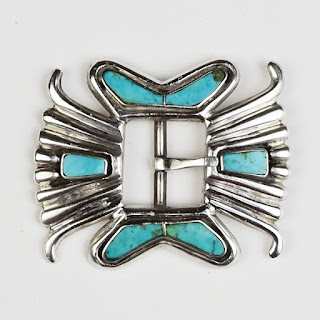Here we are in August, and our show schedule has been finalized. There is no mask mandate in Santa Fe at the moment, and things are looking pretty good here. So, here is the schedule:
Whitehawk Show:
A blog done by the people at Turkey Mountain Traders in Santa Fe, New Mexico that addresses topics of interest to anyone who appreciates and collects antique American Indian art and jewelry.
Here we are in August, and our show schedule has been finalized. There is no mask mandate in Santa Fe at the moment, and things are looking pretty good here. So, here is the schedule:
Whitehawk Show:
One of the big questions running around our part of the world lately has been, "What is going on with the August shows in Santa Fe?" Now that it has been announced that Indian Market will be going ahead in a slightly reduced form on August 21-22, come clarity has been brought to the situation. There are still questions to be answered, but here is what we know right now. Nothing is set in stone, but the information we are giving here is at least set in Jell-O.
Turkey Mountain Traders (TMT) is currently scheduled to do two shows in Santa Fe in August. The first is the Whitehawk Show at the Santa Fe Convention Center on August 13-16. Many of you have been to this show, which is without question the finest antique Indian and Ethnographic art show in the world. This year, TMT will be in a new and larger booth, right next to the front entrance. We have been stockpiling material since March of 2020, so our collection should be among the best we have ever offered. The second show is the Native Treasures show at the Eldorado Hotel, August 19-22. Unlike the Whitehawk show, this show has not been confirmed yet, but it looks promising. This is a very diverse show, with items ranging from irreplaceable treasures from the greatest living Indian artists to things that are far more affordable. This show takes place on the Thursday and Friday before Indian Market, as well as the two days of Market, and is a must-see. Works by many artists who do not exhibit at Indian Market can be found at this show, as well as vintage and antique pieces. We will be in the same corner booth as we occupied in 2019, if you visited the show then.
What is really new and exciting for TMT is that we will be moving into a new private gallery space in Santa Fe, which will be available for private showings starting on August 8. It is located fewer than 5 miles from the Santa Fe Plaza--an easy drive, with good parking. If you would like an early look at our treasures in August before the shows open, give us a call and we would be happy to welcome you to our new gallery.
What we know about Indian Market is that it will be held on August 21 and 22 on the Santa Fe Plaza, and the number of booths will be limited to 500 (down from around 850). The word is that there will be tickets for sale for entry, though how that will be handled is still up in the air. The best source for immediate information is the SWAIA website. (UPDATE: tickets for each day will be $40 for admission at 6 a.m. and $20 for admission at 8 a.m. SWAIA will begin selling tickets to SWAIA members on May 28 and to the general public on May 29.)
If you have any questions about our Santa Fe schedule, please give us a call at (480) 423-8777, or drop us an email.
The word "important" is used far too often in the art world in general, and the Southwestern Indian silverwork world in particular. Importance is a very subjective concept, and what makes something "important" is very hard to define. Is a piece "important" because it is early? Or because someone who is now famous made it? The answer to both may well be yes, but not necessarily. Early pieces can be minor and unimportant, and not everything made by a famous artist can be considered a masterpiece. How about if a piece is pictured in a book, or displayed in a major museum? Again, maybe, but maybe not.
But what if something combines all of these things? If that is the case, then calling it "important" is probably not a stretch. It is not often that such a confluence of factors occurs, and it is notable indeed when something does indeed check all the boxes. Something like that just happened in Turkey Mountain Traders' inventory, and we are excited and proud to tell everyone about it.
First, a bit of background. One of the most common questions we are asked involves hallmarks, and when they came into use in the American Indian Southwest. It is a known fact that, left to their own devices, early Indian silversmiths did not use hallmarks until the mid-1920s, and infrequently even then. After much coaxing by traders and patrons, hallmarks came into more common use in the 1930s and 1940s, and today it is unusual for an Indian smith to not hallmark their work. The absolute earliest that a hallmarked piece can be found with a solid date is 1925, and that piece is shown below:
 Very slightly different, but clearly by the same hand using the same techniques (casting and channel inlay) and done at the same time. And how about a hallmark?
Very slightly different, but clearly by the same hand using the same techniques (casting and channel inlay) and done at the same time. And how about a hallmark?